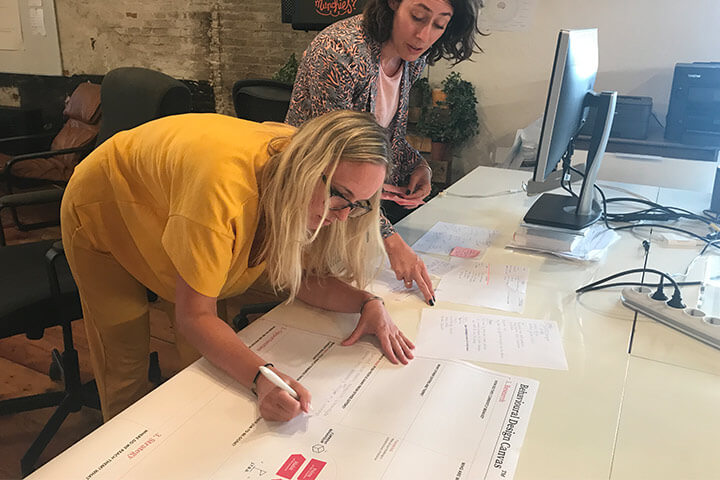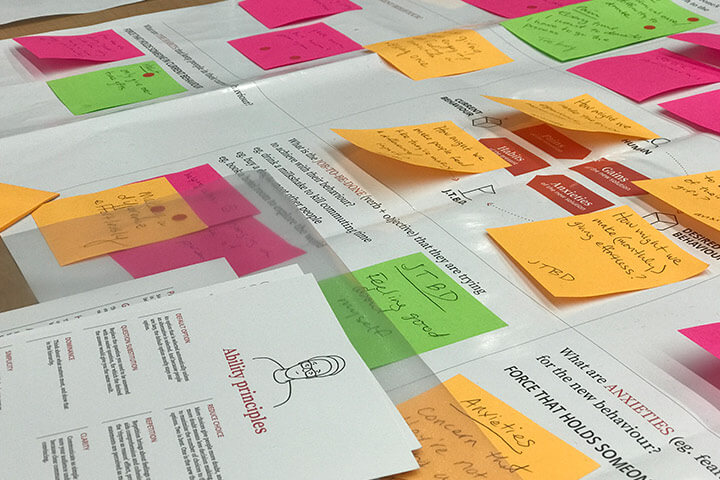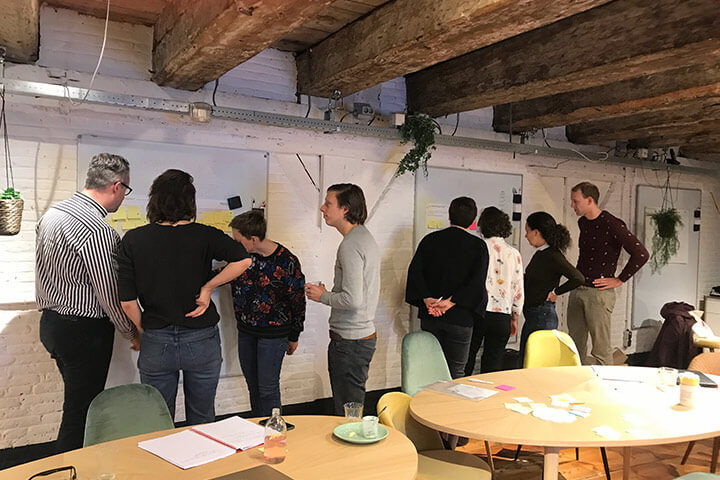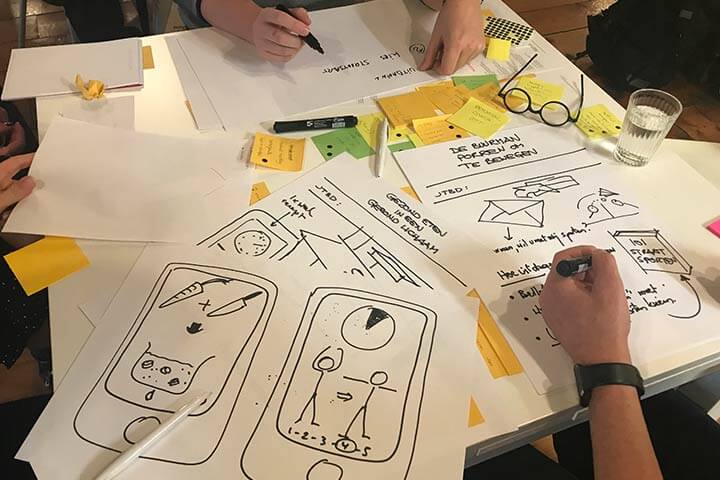If there is one thing we as humans all want more control over, it is our own happiness. Thousands of self-help books have been written, bought and earmarked. Maybe one of the pieces of advice you have come across is this quote: ‘You’re the average of the five people you spend the most time with’. From a behavioural science point of view, this is intriguing, as behaviour is strongly influenced by context. We all act and react to what happens around us. Can we learn from behavioural science what kind of people we must surround ourselves with? How can we influence our context to trigger behaviours that make us flourish as human beings? Or to go beyond this: How do these insights transfer to a business context? Can it help create better performing teams and more motivated talent? This blog post will give some answers from a Behavioural Design point of view.
Happiness: The five people you hang around with
You probably have heard or read it before that we as humans are hard-wired as social animals. When we grow up, we learn the values, norms, and desired behaviours by looking at others and adapting to them. We feel better when we fit in a group. We prefer inertia, but one of the key motivators for us to spring into action is when our group is threatened by another group. That’s why the ‘creating an enemy’ tactic is so vital in getting people on your side in, for instance, winning political votes. At one point or another, we all have been influenced by social proof to buy, book or belief something. From a happiness point of view, this also has a strong effect on us. You could say that:
Our quality of life equals our quality of relationships.
However, there is this interesting paradox. At the same time, we all live in an identity economy. We are constantly searching to answer that one question: ‘Who am I?’ and we repeatedly do and say things to establish our identity. This is not surprising as most of us were raised for autonomy. It is a merit to be independent, make our own decisions, have self-motivation, and have high expectations of our ability to direct our own lives. Happiness isn’t an option anymore; it is a mandate or almost a right to be.
You probably have been looking for ways to be happy yourself once or twice. If that’s the case, I better put it to you straight: behavioural research has shown that looking for happiness has no use at all. Reading all those self-help books, turning inwards, and searching for your inner purpose: Won’t do the trick. This doesn’t mean we cannot be happy; we simply must first understand ourselves a bit better. We need to understand the psychology of happiness.
Designing happiness: predicting our happiness
If we want to be happy, one of the first things we need to look into is our ability to predict what makes us happy. Let me ask you a question: Suppose you won a lottery, and 1 million euros are transferred to your checking account. Now imagine a completely different scenario. This time you had the unfortunate experience to be involved in a traffic accident that made you paralysed from the hips down. After a year, if I ask you what is your level of happiness? Is it the same in both scenarios or is one higher than the other? I suppose, you think your happiness level will look something like this: as a fortunate lottery winner you picture yourself being far happier than as a unfortunate paraplegic.
What if I tell you these are the wrong data? Daniel Gilbert PhD, professor at the Harvard Department of Psychology, researched this, and these were the correct data:
There was hardly any difference in happiness levels after a year. This was a profound insight into the psychology of happiness. Daniel Gilbert discovered that we all have a psychological immune system that helps us handle setbacks and prevents our happiness from being negatively influenced. It shelters us from the worst effects of misfortune.
This is important as this study has shown that we are not good at forecasting our responses to emotional incidents. We typically overestimate how long we will be unhappy after a negative incident, which, in turn, affects our behaviour and decision-making. According to Daniel Gilbert, PhD:
We underestimate how quickly our feelings are going to change in part because we underestimate our ability to change them; this can lead us to make decisions that don’t maximise our potential for satisfaction.
You can see how this may affect our happiness, or as Daniel Kahneman, PhD, who conducts research on decision-making and wellbeing, said:
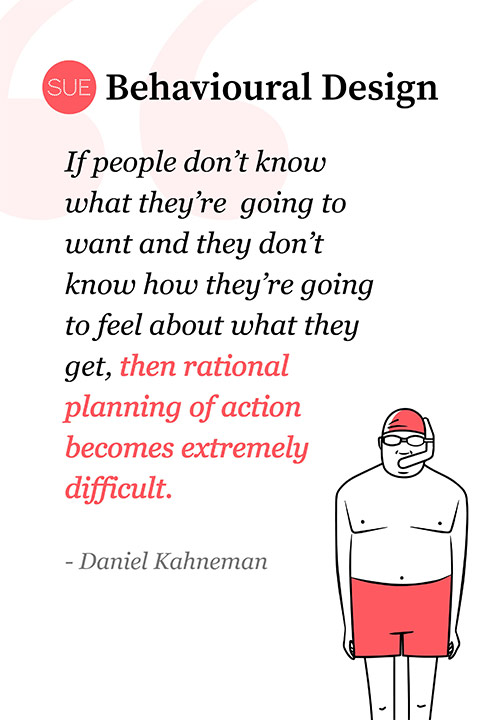
What people tend to do is either avoid decisions, or they build in securities by over-relying on freedom of choice. If you have more options, this gives us the feeling of having more room to escape. However, behavioural research has also shown that having more options tends to have adverse effects on the quality of our decision-making. We often tend to pay more for more options, but this is a waste of money from a happiness point of view.
Designing happiness: what makes us happy?
But there is more. We now know that we are not good at predicting our happiness, but that doesn’t tell us what makes us happy. Behavioural science has something fascinating to say about this, too, as we have another psychological mechanism know as hedonic adaptation, also known as the hedonic treadmill. It refers to the human inclination to quickly return to a relatively stable level of happiness despite major positive or negative events or life changes.
You can compare it to a treadmill as even if a runner is running, he (or she) stays at the same place. If you do something you love or like the joy you get from it levels out. We all return to our happiness baseline. The mechanism helps us cope with unpleasant experiences but it also is a killer for joy. Happiness doesn’t last.
Maybe, you are now a bit discouraged if you can indeed design a happy life. You can. If there is one element that drives our happiness that researchers found repeatedly, it is curiosity. When we are open to new experiences, when we cherish the unknown, when we are inquisitive, it has been shown that we tend to hover above the happiness baseline for a more extended period. We can even shift our baseline a bit upwards.
Designing happiness: the freedom security paradox
This brings us back to the paradox we started out with our innate need to be socially connected and independent. This paradox starts to make sense when we want to design our happiness. Esther Perel once said we all have two human needs: security and freedom. You could say we all balance between change and stability all the time. You need your freedom as it drives that so much needed imagination, playfulness, curiosity. However, it is much easier to change if you can jump of a stable foundation of people who are committed to your wellbeing.
It is also much easier to be curious if you are inspired by interesting people. In fact, if we get disconnected from people, we can experience all forms of stress: despair, sadness, exhaustion, confusion. Just think back at the Covid lockdown; these were all emotions people have genuinely experienced and suffered from. This leads up to a fascinating Behavioural Design challenge:
How can we design behaviour that makes us feel connected, curious, and playful?
This is also where our personal happiness and work happiness come together: the same behavioural interventions can work for both. In both situations, you are a human in a relationship with other humans. Losing the other is losing yourself.
Want to learn how to design behaviour?
Join our two-day Fundamentals Course and master a hands-on method to use behavioural science to develop ideas that change minds and shape behaviour.
Designing happiness advice 1:
Create an interdependent context.
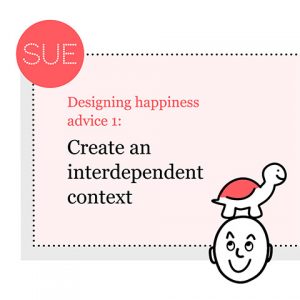
Maybe the most critical shift we need to make is a shift in our context. We need to design a context that is shaped for inter-reliance or inter-dependence. Make it okay to be dependent on each other. You can be playful and imaginative if you are not afraid that you will be judged. If you can rely on each other this creates collective resilience sparking the willingness to try new things. To accomplish this, you need to design for psychological safety. This is a shared belief held by team members (or partners) that it is safe for interpersonal risk-taking.
Research has shown that this builds team efficacy, learning and performance. But psychological safety also helps to establish stable relationships. It creates the courage to speak up no matter how you feel about yourself, you will open up about your struggles, and it helps you take a step toward what you want. It also helps you propose new plans and experiment together. Some tangible behaviours that lead up to psychological safety:
- Be understanding: Summarise, use language like ‘Do I understand it correctly that you want.
- Avoid blaming: Don’t say: ‘Why did this happen?’ or ‘Why did you do this?’, but ‘How can we make sure to make this better next time?’
- Avoid negative: Don’t use negative words; it creates an interpersonal culture of rejection.
- Manage speaking time: Making sure everyone can speak in an equal amount.
- Explain decisions: you don’t need to have a democracy in everything, but it helps to explain a decision.
- Be engaged: Make eye contact, don’t use phones in conversations, be present.
Designing happiness advice 2:
Surround yourself with complementarity.
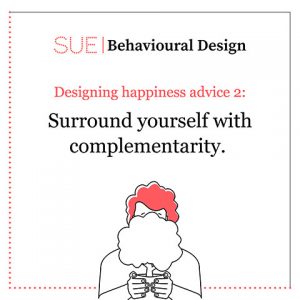
This is where the five people that you surround yourself comes in. If you look back at the first intervention, you can imagine that:
Interdepend roles create strength.
So, look around those five people. Are they different from you? Do they complete you? Do you get energy from them, or do they suck the living daylights out of you? It maybe feels safer to hang out with like-minded people, but it can be very inspirational to talk and meet with people with different experiences and opinions. Some tangible behaviours:
- Plan a meeting with someone who has a different opinion.
- Make a list of the five people who could compliment you and schedule meetings with them.
Designing happiness advice 3:
Have a prototyping mindset.
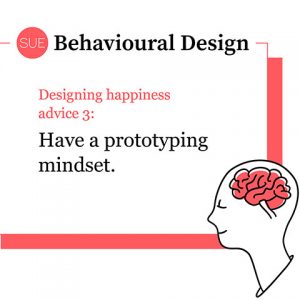
What holds us back from being curious is the lack of courage to do new things. We know from behavioural science that it is crucial to believe in yourself. If you don’t have confidence, you struggle in your relationships, and you don’t feel very happy at work, you don’t cope well with stress, which causes you to lack motivation or energy. On the other hand, research has shown that having confidence can help you set boundaries, find balance in your work and private life, improve performance at work through better concentration and commitment to tasks.
This again affects whether we dare to engage in experiences that might feel uncertain or can be risky. Expectations of personal efficacy determine whether coping behaviour will be initiated, how much effort will be expended, and how long it will be sustained in the face of obstacles and aversive experiences. A great behavioural design intervention is to build confidence is to establish a prototyping mindset.
If you look at everything you do as an experiment, you cannot fail only learn.
Everything new is not likely to give us courage but approaching life, and new ventures as one big experiment builds trust in yourself. It’s the fuel for our curiosity engine.
Designing happiness advice 4:
Build respect and recognition.
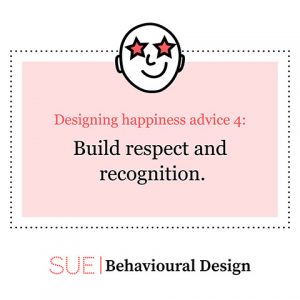
Most relationships start to fail, both in your work and private life when you don’t feel valued anymore. We all have an innate need for respect and recognition. When we have the feeling we are not valued anymore, we cut ourselves loose. There is a straightforward behavioural intervention to make people feel valued. It is giving compliments.
There is more to it: a study from 2012 suggests that receiving praise helps our brain remember and repeat the skill when we try out a new skill. One-third of participants received compliments for their own performance, one third received for another participant’s performance, and the others received no compliments. The next day, the group that received praise for their own performance performed better on the task than the others.
Another benefit of giving compliments is that it can affirm desired behaviours, which can be helpful not only in your work but also in maintaining stable friendships or romantic relationships.
Designing happiness advice 5:
Be as pleasant at home as you are with your clients.
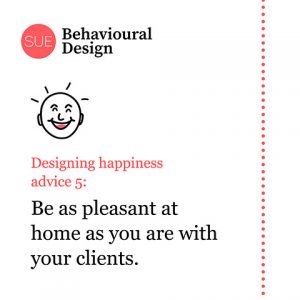
It may seem like an open door but be honest, have you have ever caught yourself changing your behaviour as soon as you got home? Whereas you could be interested, caring and curious in client conversations at home, you stop asking genuine questions to find out how your life partner is doing. You probably have heard about the seven-year itch. Well, in fact, research has shown you are actually dealing with a three-year itch. After three years, we think we know everything about our partner: what he she/likes, what he she/does. But do you? You’re not together for the most part of the day, so your partner does have new experiences, thoughts and dreams, perhaps. A simple behavioural intervention is to keep asking questions. Be interested. Do you have your phone in your hand when you’re talking to an important client or your boss? No. Treat your life partner or teammate with the same respect.
Designing happiness advice 6:
Leave your devices behind.
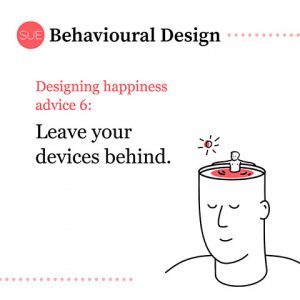
This makes an easy cross-over to this behavioural intervention. If you want to build a meaningful relationship with someone, both at work and at home, make sure you are engaged. Make eye contact, turn off that phone, don’t look at your laptop when you are in a conversation. This builds trust and respect that is needed to get playful, curious and experimental. Looking to improving your sex life? Leave the communication devices out of the bedroom!
Want to shape behaviour and decisions?
Then our two-day Fundamentals Course is the perfect training for you. You will learn the latest insights from behavioural science and get easy-to-use tools and templates to apply these in practice right away!
Summary: How to design happiness
Pursuing happiness is not an abstract matter and, most of all, not a matter of heavy, introspective labour. By using behavioural science, we can carefully design a context that balances our need for freedom and security. Both essential ingredients for a happy life. Our job is to make sure that the pendulum between the two doesn’t snap. We thrive and feel alive in social connection that sparks curiosity. These are the main drivers of our happiness. We need to rely more on each other. If we can stay connected, curious and playful, all our relationships will thrive. Some very simple behavioural interventions can help us design a context that helps us do so. And remember, you cannot always be happy, but you can always be curious.
BONUS: free ebook 'Six Rules for Designing your Happiness'
Especially for you we've created a free eBook 'Designing Happiness'. For you to to easily keep the insights in this blog post at hand and use them at will—a little gift from us to you.
References (in order of appearance):
Rohn, Jim. The five people you surround yourself with. www.jimrohn.com
https://www.apa.org/monitor/oct01/strength
https://www.estherperel.com/blog/letters-from-esther-2-security-and-freedom
Hawbaker, J. (n.d.). The benefits of self-confidence. Birmingham Counselling Services. Retrieved from https://birminghamcounsellingservices.co.uk/the-benefits-of-self-confidence
Flora, Stephen Ray (2004). The Power of Reinforcement. SUNY series. Alternatives in Psychology.
https://www.leidenpsychologyblog.nl/articles/world-compliment-day-the-science-behind-praise
Featured cover image by Hybrid on Unsplash.
Read or Watch more
Insights about Happiness
A Behavioural Designer’s Guide to Happiness: blog post
De Wetenschap van Geluk (Dutch): video
The Behavioural Design of Joy and Happiness: blog post
Prototyping Happiness: blog post
The Behavioural Design of Love and Desire: blog post
Personal Coaching is Pointless: four Reasons: blog post
How do you do. Our name is SUE.
Do you want to learn more?
Suppose you want to learn more about how influence works. In that case, you might want to consider joining our Behavioural Design Academy, our officially accredited educational institution that already trained 2500+ people from 45+ countries in applied Behavioural Design. Or book an in-company training or one-day workshop for your team. In our top-notch training, we teach the Behavioural Design Method© and the Influence Framework©. Two powerful tools to make behavioural change happen in practice.
You can also hire SUE to help you to bring an innovative perspective on your product, service, policy or marketing. In a Behavioural Design Sprint, we help you shape choice and desired behaviours using a mix of behavioural psychology and creativity.
You can download the Behavioural Design Fundamentals Course brochure, contact us here or subscribe to our Behavioural Design Digest. This is our weekly newsletter in which we deconstruct how influence works in work, life and society.
Or maybe, you’re just curious about SUE | Behavioural Design. Here’s where you can read our backstory.

